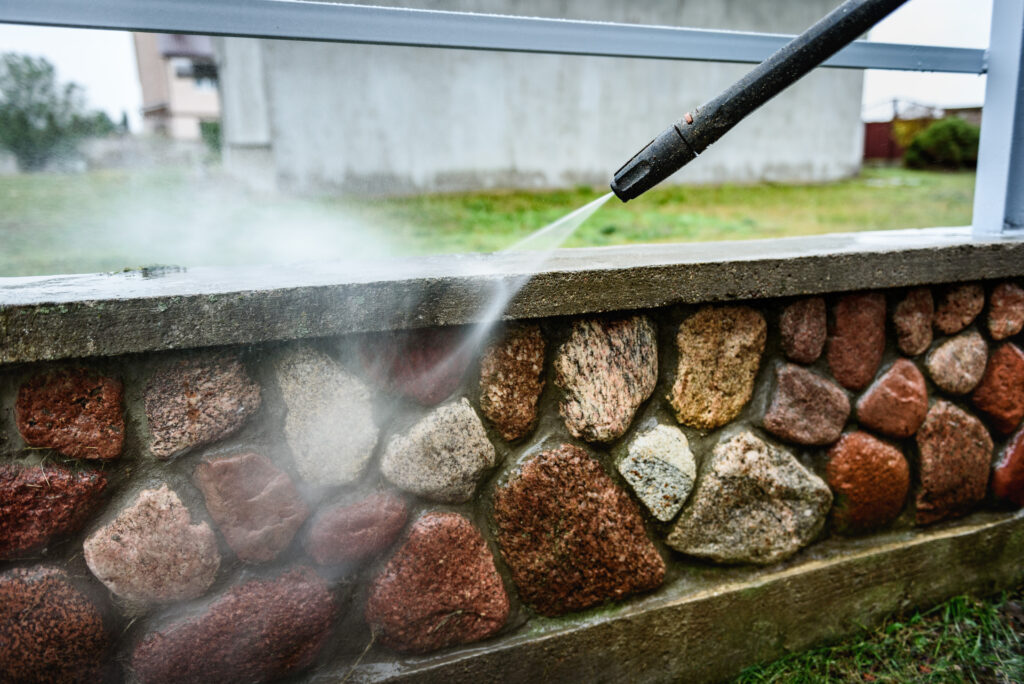
Retaining walls do more than hold back soil—they create clean landscaping lines, manage drainage, and add curb appeal. But over time, these walls collect moss, dirt, algae, and staining that dull their appearance. Pressure washing can breathe new life into them—but done incorrectly, it can also damage the mortar, weaken the structure, and lead to costly repairs.
This guide shows you how to pressure wash a retaining wall safely, efficiently, and without compromising the integrity of the mortar joints. Let’s get into it! 🧼🧱
🧭 Why Clean Your Retaining Wall?
Retaining walls face constant exposure to:
- Rain runoff and splashback 🌧️
- Moss and algae from shaded areas
- Dust, pollen, and airborne debris
- Mineral deposits and efflorescence
- Mold or mildew (especially on concrete blocks)
Cleaning them improves your landscape’s appearance, increases property value, and extends the life of the wall.
🧰 Tools and Supplies You’ll Need
- Pressure washer (1,200–2,000 PSI max)
- 25° and 40° spray nozzles
- Soft-bristle scrub brush
- Mild masonry-safe cleaner or vinegar solution
- Bucket and sponge
- Water hose
- Safety glasses and gloves 😷🧤
💡 Never use high-pressure tips (like 0° or turbo nozzles) on mortar—they can cause crumbling or blowouts.
Browse Amazon Here For Top Rated Power Washers And Accessories
🛠️ Step-by-Step: How to Pressure Wash a Retaining Wall Safely
1️⃣ Inspect the Wall
Before any cleaning begins:
- Check for cracks, loose stones, or crumbling mortar
- Make note of any drainage outlets or weep holes
- Avoid pressure washing if you find major structural damage—repair it first
📸 Take a photo beforehand so you can compare results after cleaning!
2️⃣ Remove Surface Debris
Use a broom or soft brush to remove:
- Dry leaves
- Cobwebs
- Dirt clumps
- Loose gravel or mulch
This prevents clogging your pressure washer or muddying the wall as you clean.
3️⃣ Pre-Soak the Wall
Using a garden hose or your pressure washer’s lowest setting, spray down the wall to:
- Loosen surface dirt
- Saturate the mortar, which helps prevent water absorption of harsh detergents
- Start softening any moss or algae
4️⃣ Apply a Masonry Cleaner
Use a concrete or stone-safe cleaner diluted per instructions. Alternatives include:
- 50/50 vinegar and water
- Enzyme-based outdoor cleaners
- Algae and mold removers
Spray the solution on with a low-pressure nozzle and let it sit for 10–15 minutes. Don’t let it dry—keep it damp during dwell time.
5️⃣ Gently Scrub Stained Areas
Use a soft or medium-bristle brush to scrub:
- Green algae or mildew
- Moss buildup in corners
- Rust stains or mineral deposits
Be gentle—scrubbing too aggressively can scrape mortar or damage stone veneers.
6️⃣ Pressure Wash With Care
Attach a 25° or 40° nozzle and use medium-low pressure (under 2,000 PSI):
- Hold the wand 12–18 inches away
- Spray at a 45° angle to avoid hitting joints head-on
- Work in horizontal strokes from top to bottom
- Rinse each section fully before moving on
🚫 Never spray directly into mortar lines—especially older walls with soft joints.
🧼 Cleaning Tips for Different Wall Types
| Wall Material | Tips |
|---|---|
| Concrete block | Most durable; OK to use moderate pressure |
| Stone veneer | Use extra caution—fragile faces and thinner mortar |
| Brick | Test a small area first; softer mortar may erode |
| Timber ties | Do not pressure wash—clean by hand only |
| Interlocking pavers | Usually safe with low pressure and fan nozzle |
❌ Common Mistakes to Avoid
- ❌ Using a turbo nozzle—too harsh for joints
- ❌ Skipping the pre-soak or detergent step
- ❌ Holding the wand too close—can dig out mortar
- ❌ Spraying directly upward into drainage holes
- ❌ Cleaning on hot sunny days—causes streaking and fast drying
🌱 Eco-Friendly Cleaning Options
- Use biodegradable cleaners
- Avoid bleach near grass or flowerbeds
- Block runoff if near a storm drain
- Consider using vinegar + baking soda for mold and algae
🧱 Maintenance Tips to Prevent Future Buildup
- Trim overhanging plants to reduce shade and moss
- Improve drainage around the wall to prevent pooling
- Seal the masonry annually with a breathable sealer
- Inspect regularly for cracks or new discoloration
🗓️ How Often Should You Clean?
| Environment | Suggested Cleaning Frequency |
|---|---|
| Shady/damp | Every 6 months |
| Dry/sunny | Once per year |
| High-traffic | Twice per year |
💬 Final Thoughts
A clean retaining wall instantly boosts the appearance of your property, but more importantly, it protects the wall from long-term damage. With the right nozzle, cleaner, and technique, you can blast away years of grime without compromising the integrity of your mortar joints.
Take your time, avoid excessive pressure, and use the proper cleaning solutions—and your retaining wall will keep standing tall and looking great for years to come! 🧱🧽✨
Browse Amazon Here For Top Rated Power Washers And Accessories



